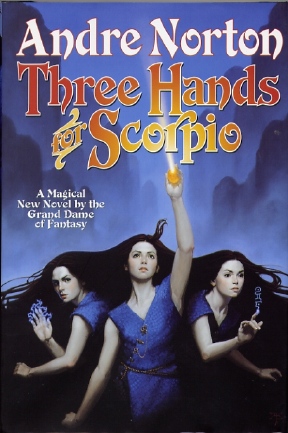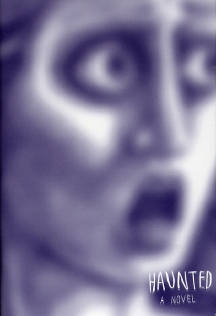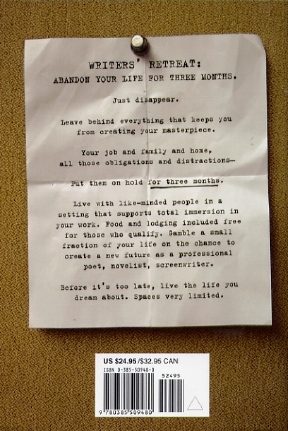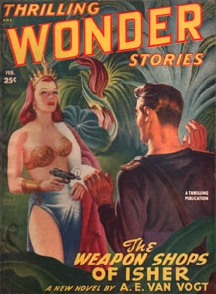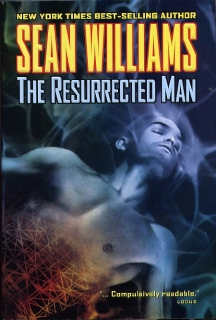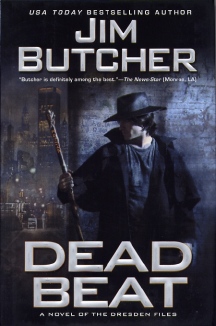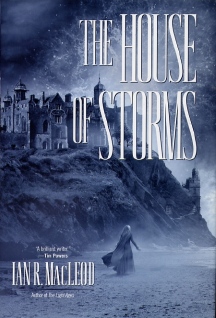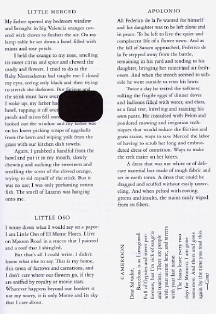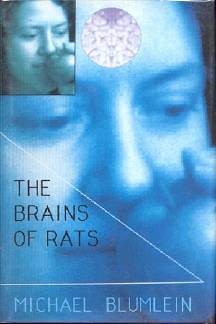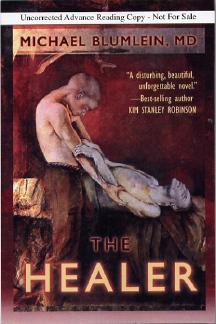|
|
|
This Just In...News from the Agony Column
|
04-22-05: Andre Norton 'Three Hands for Scorpio' |
|||
An
Author's Farewell
If this encomium seems to be coming a bit late, well, it's my inclination to talk about the writer's work. That's what we read and that's why we care about any of this. Through their work writers reach us and touch us more directly than any might in person. The connection between a reader and a writer is more intimate than most will care to admit. It's a direct-level access that science fiction writers have imagined in terms of a mind-machine interface and that scientists are even now working to create. We're seeing the first evidence and examples that our minds can be used to control machines. But even then, the connection between reader and writer is more intimate, more intimate, I would say than any potential for even telepathy. This is because of the trust that is established between a writer and a reader. When a writer sits down to start a book or story, they must trust the reader to perform a sort of creative miracle to make the reading experience. The reader must trust the writer to provide a reading experience that will be satisfying. Both parties provide creative input to the total encounter, an encounter where the two parties will usually never meet, or even be specifically aware of one another. Reading is an abstract intimacy. 'Three Hands for Scorpio' (Tor / Tom Doherty Associates ; April 20, 2005 ; $23.95) is your last message from the mind of Andre Norton. What makes this occasion so special, joyous even is the fact that Norton clearly kept her eye on the prize, providing in her final novel the same caliber of literary excellence that marked her career. Norton never wrote the Great American Novel, nor did she write the most meaningful book ever written. Andre Norton wrote sturdy, well-crafted, imaginative novels of fantasy and science fiction for an audience that might be thirteen or thirty, nine or ninety years old. 'Three Hands for Scorpio' is no exception. Drucilla, Sabina and Tamara are identical triplets, the daughters of the Earl of Scorpys. Theyre kidnapped and taken to a surreal realm known as The Dismals. There they will fight monsters and the dark lord of the realm who may be friend or foe. Theyll use their innate telepathy -- not as good as reading, but probably handier when you're trapped in a surreal underworld -- to get out, get home and find their own unique skills, the abilities that will help them heal not only their world but perhaps others as well. Set in a world reminiscent of the border between Scotland and England in the sixteenth century, 'Three hands for Scorpio' is more properly set in the borders between you and Andre Norton. With two hundred books, that's a long and complex border. The most pleasurable aspect of this novel is the realization that while it is Andre Norton's last novel, it is for someone else, most certainly, the first novel they will truly enjoy. Another mind read, another connection made. Without doubt, telepathy can be most helpful, especially if youre trapped in a surreal underworld. But reading can get you out of this world. With it you can cross the barrier between the living and the dead, so that you need never leave them behind. A priceless talent that has no price. Thanks, Grand Master Norton. I'll see you in Witch World. |
|
Chuck Palahniuk is 'Haunted' by Hype |
|||||||||
A
Novel In Stories
Here's the set-up for this fix-up. At a writer's retreat, the lucky participants write some stories. But this is no pack of wannabes in a forest setting. This is a group of increasingly irate and hungry people locked in an enormous theater. Supplies are running short, tempers are getting shorter, and the stories are getting more extreme as each participant just wants to be the one to be heard as well as fed. Palahniuk has his sights set on Reality Television; think Clarion Workshop as produced by the folks who do 'Survivor' -- and remember that's the title of one of Palahniuk's most beloved actual novels. When you put it that way there's the potential for a fair amount of satiric humor, and Palahniuk is an accomplished if grim humorist.
Between the stories told by the participants are poems about them and tiny bits of interstitial material meant to tape the whole thing together. All in all, the signs are rather mixed I'd say. On one hand, you have the immortal fix-up, generally taken to be a bad sign in the world of genre fiction. On the other hand, some of genre fiction's most important titles were fix-ups. I'm not sure whether he's in or out of favor this year, but back when I was a pup, A. E. Van Vogt's 'The Weapon Shops of Isher' was required reading and it boggled my pre-teen mind. It was almost certainly his most famous fix-up, a term he himself coined to describe his strictly economically-inspired practice of stringing together short stories he'd already been paid for into a novel that would generate new income. 'The Voyage of the Space Beagle', another famous fix-up, inspired both 'Star Trek' and 'Alien'. In fact, Van Vogt sued the makers of 'Alien' based on its similarities to one of the stories in 'The Voyage of the Space Beagle' and he got $50,000 out of them. So you'll see that Harlan Ellison was not alone in suing Hollowood when it felt free to pilfer from genre fiction without recompensing the authors who created the stolen stories.
'Haunted' is certainly a must-buy collection, if for nought else than the stomach-churning 'Guts'. But there's a good deal more here than meets the eye, whether that eye is searching for a novel, a short story collection, a fix-up, a few good laughs or a few quick chills. Those who have plumbed the depths and reached the heights with Palahniuk will be pleased regardless of which direction he takes. The rest are advised not to stray to far from uh, a proper receptacle. |
|
04-20-05: Sean Williams' 'The Resurrected Man' |
|||
Mature
Future Mystery
Now however, punk rock is fodder for nostalgic re-unions and the future foreseen by the original crop of cyberpunks has been ground beneath the wheels of the present. Our lesson: the future is usually more like the past than, well, "the Future". So when a writer delivers us a fat novel full of high tech murder, let's not call if cyberpunk. Let's call it a Mature Future Mystery. So, you want your MFM? Pyr's got your MFM, folks. It would be Sean Williams' 'The Resurrected Man' (Pyr / Prometheus Books ; April 12, 2005 ; $25). And with it, Williams resurrects a novel that first saw publication as an Australian paperback but is just now getting the hardcover version it deserves from Pyr here in the States. It looks like a rockin' good time and Pyr has done an outstanding job bringing this novel to US readers. You've got a lovely cover by John Picacio and equally important to my aging eyes, a very generously printed 529 page novel with nicely-sized type and great leading (that's the distance between the lines) that make it a joy to read. You might not think this sort of thing matters to you, but trust me, it does. Especially when you have what appears to be a hard-core, page-turning, toe-tapping novel of terror. Not that Lou Anders has already violated his statement from my interview with him that "you are unlikely to see horror coming out of Pyr." And sure, I understand what he means, but 'The Resurrected Man' is probably not for the faint of heart. And it certainly is for readers who like to complicate a great mystery with a nice technological McGuffin. From what I can discern, readers who enjoyed Richard Morgan's 'Altered Carbon' will be quite interested. Williams has come up with a simple idea that has complex ramifications and the potential for highly entertaining complications. Private Detective Jonah McEwan is wanted for murdering women who resemble his former colleague Marilyn Blaylock. The only problem is that he's been in a coma for three years, a coma he has no memory of entering. And worse? Using teleportation technology that scientists are even now hard at work on, a serial killer has been creating, then brutally torturing and killing perfect facsimiles of his victims, while leaving the original, the "victim" alive and untouched. Is it even murder? Williams' novel works both the science fiction and mystery genre tropes with equal fervor. He references Agatha Christie (and we say that like it's a good thing) and follows the conventions of the mystery form. To me, this novel offers the potential to be equally thought-provoking and page-turning, without getting overly caught-up in reversing the neutron flow. This is clearly not your old man's cyberpunk. It's Pure Pop for Now People, science fiction and mystery fiction all grown up, no punks required, no nostalgia allowed. Get used to the grit, it's here to stay. The near future is always going to be gritty, at least, until the present cleans up its act. Though the stink of the city air might make you inclined to do so, dont hold your breath waiting for it to happen. The present only gets cleaned up in retrospect, in the happy glow of nostalgia. Think about it. Someone, somewhere in the future will be pining for this present, right now. Can you feel the golden glow all around you? You're oh so mature. |
|
04-19-05: Jim Butcher 'Dead Beat'; Ian R. Macleod's 'The House of Storms' |
|||
Dresden
Files Debut in Hardcover
He goes on to say that his greatest love thereafter was what he calls "swords-and-horses fantasies." As a writer, he spent years trying to write one that would sell, but also branched out into other areas, "including SF, mystery and contemporary fantasy. That's how the Dresden Files came about -- as a happy accident while trying to accomplish something else. Sort of like penicillin." It's fitting then, that his first hardcover novel was the first volume of his own swords-and-horses fantasy, 'Furies of Calderon'. But it's also about time that his supernatural detective, Harry Dresden, got the nod, and he finally does in 'Dead Beat'. This time around, Harry is called on by his friend in the Chicago PD Karrin Murphy. It seems that Mavra, one of Chicago's deadlier vampires, has some dirt on Murphy that she'll spill unless Harry finds Mavra the Word of Kemmler, and all the power that comes with it. Of course, turn over one rock and lots of stuff scuttles out into the daylight. Bad stuff, and Harry's pretty much on his own dealing with it. For me, Butcher has done a number of admirable things. First is that he persevered long enough to get himself in print, and that he was willing to find his strength even if it wasn't his favorite kind of fiction to read. To wit, he made his mark first in the supernatural detective biz as opposed to the swords-and-horses biz. But I'm also gratified that he's kept the focus on Harry's supernatural investigations. For this reader, the mix of mystery fiction and supernatural fiction allows the author to explore our inner world more fully while keeping a close connection to our outer world. Butcher's author's note touches mostly on his new fantasy. But the presence of this note at the end of a honkin' hardcover Harry Dresden novel says something much stronger than any addendum. It's a message to both the reader and the author that perseverance pays. After five paperback originals, readers can now enjoy Butcher's Dresden files in hardcover. Some readers may feel that the rewards have been reversed; they're now paying hardcover prices for their favorite paperback fiction. Those who do need simply wait, but that would certainly not be my advice. I'd suggest that you line up to buy this hardcover and those that follow. That is, if you want to see them follow. |
|||
US
Hardcover Arrival
'The House of Storms' is a sequel of sorts to 'The Light Ages'. While the former novel evokes Dickens, and most specifically, 'Great Expectations', Macleod told me in an interview for the latest issue of Interzone that for 'The House of Storms', "Hardy was high up on the list. And Marion, the books main if probably most elusive character, was intended as a Hardyesque heroine. And I have to mention Ian McEwans Atonement, which I read just as I was getting into the book, and helped reinforce my idea of the perfect but nevertheless destructive summer from which the rest of the book evolves. That, and perhaps L.P. Hartleys The Go-Between. Not that the end results anywhere near these books, but thats okay. Writings about setting out to do one thing and ending up doing something else." You'll have to pick up Interzone to find the rest of the interview, which of course, I heartily endorse. But at least you can get 'The House of Storms' here in the US in a brand-new hardcover first edition in the same year as the UK release. Slowly but surely, publishers are picking up on the reader's requests to have books come out simultaneously in the US and the UK, so that those of us who must read -- or at least buy -- the books when they first come out can do so without paying the often extravagant postage. On the other hand, those of us who are willing to do so will probably buy both editions in hardcover anyway. Of course reading is supposed to be about reading, not collecting. But somehow, one compulsion follows the other. And readers are left the happy fate of not missing the money they spend on dueling editions, because they're quite busy --and happy, thank you very much! -- spending all their time reading. |
